Aquarium Conditioned
Volitan Lionfish, Colored
Pterois volitans
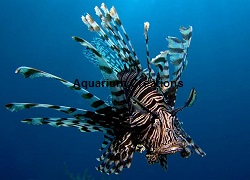
You Tube Video of the Volitan Lionfish
Description:
The Colored Volitan Lionfish is also known as the Lionfish, Red Volitan, Black Volitan, Turkeyfish and Butterfly Cod. They have vertical stripes along their body that vary in color from red, to dark burgundy to black and eye catching banded spines on both the dorsal and large flowing pectoral fins. Known to spend time out in the open at dusk and dawn, in the ocean they hide in caves and under rock shelves during the daylight hours. Due to the venomous nature of the dorsal spines on the Volitan lionfish, you must exercise caution when working in your aquarium. Volitan Lion's adapt well to captivity when provided proper food and provided with needed places to hide such as crevices and caves. Keeping a lower light level will provide better viewing because they are active at night. Volitan Lionfish will prefer getting a great meal handed to them but they may eat smaller fish, shrimp, and other crustaceans in the tank if hungry.
Tank Recommendations:
The Volitan Lionfish can grow to be from 16 to 18 inches in the ocean, a little smaller when housed in an aquarium. Therefore when full grown house in a 125 gallon aquarium or larger with a number of hiding places and a large open area for swimming.
Food and diet:
Though we do our best to have our Lionfish accepting a captive diet, many times lionfish revert back to live foods due to the stress of shipping and a new environment. If your Lionfish is not eating, we recommend feeding live Feeder Shrimp mixed with frozen mysis shrimp. Slowly increase the frozen mysis shrimp and decrease on the live Feeder Shrimp. Eventually cut out the live all together. This can take a few days or a few weeks depending on the stress level, health, age, and willingness on the individual fish.
The Lionfish diet consists of meaty foods such as live shrimp, live fish, and crustaceans. When first brought into your home aquarium use live saltwater feeder shrimp and feeder fish to entice your lionfish to eat. Once comfortably eating the above in the aquarium, start working with frozen mysis shrimp, pieces of uncooked table shrimp, pieces of thawed out silversides, and pieces of thawed out frozen squid.
Level of Care:
Moderate
Acclimaton Time:
3+ hours
Reef Compatibility
:with caution
Approximate Purchase Size:
Medium 3-1/2" to 4-1/2" Medium/Large 4-1/2" to 6" Large 6" to 7-1/2" XLarge 7-1/2" to 9"
Stung by a lionfish?
Lionfish spines on the dorsal, pelvic, and anal fins are all venomous. If accidentally stung, the affect is similar to a strong bee or wasp sting. The most important thing to remember is HEAT! Lionfish venom contains proteins that are broken down by heat, which takes the pain away and prevents the proteins from entering the bloodstream. After a sting, carefully remove any broken spines that may be in your wound and immediately place the wound in the hottest water you can stand (not scalding), keep heating more water with a microwave. Keep hot water on the wound for 30 minutes. The heat will clear the venom and remove the pain. Just remember, if the sting warrants, seek medical attention. Only you know how serious your condition is.
|
Medium $99.99
Medium/Large $149.99
Large $199.99
XLarge $379.99
|
|
Aquarium Conditioned
Dwarf Lionfish
Dendrochirus zebra
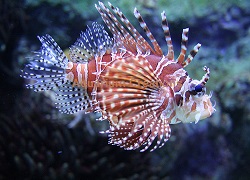
You Tube Video of the Dwarf Lionfish
Description:
The Dwarf Lionfish which is also called the Zebra Lionfish, is one of the perfect lions for small aquariums. Any fish kept with the dwarf lionfish need to be too large for it to swallow whole. The Dwarf has striking markings and long pectoral and dorsal fins. The body is reddish with five dark bars, alternating with thin dark bars in large specimens. There is a dark spot on the cheek. Median fins have small dark spots. They are slow-moving and not aggressive. Known to spend time out in the open at dusk and dawn, in the ocean they hide in caves and under rock shelves during the daylight hours. Dwarf's adapt well to captivity when provided proper food and provided with needed places to hide such as crevices and caves. Keeping a lower light level will provide better viewing because they are active at night. Dwarf Lionfish will prefer getting a great meal handed to them but they may eat smaller fish, shrimp, and other crustaceans in the tank if hungry.
Tank Recommendations:
An adult dwarf lionfish will do well in an aquarium as small as 30-gallons with a number of hiding places and a large open area for swimming.
Food and diet:
Though we do our best to have our Lionfish accepting a captive diet, many times lionfish revert back to live foods due to the stress of shipping and a new environment. If your Lionfish is not eating, we recommend feeding live Feeder Shrimp mixed with frozen mysis shrimp. Slowly increase the frozen mysis shrimp and decrease on the live Feeder Shrimp. Eventually cut out the live all together. This can take a few days or a few weeks depending on the stress level, health, age, and willingness on the individual fish.
The Lionfish diet consists of meaty foods such as live shrimp, live fish, and crustaceans. When first brought into your home aquarium use live saltwater feeder shrimp and feeder fish to entice your lionfish to eat. Once comfortably eating the above in the aquarium, start working with frozen mysis shrimp, pieces of uncooked table shrimp, pieces of thawed out silversides, and pieces of thawed out frozen squid.
Level of Care:
Moderate
Acclimaton Time:
3+ hours
Reef Compatibility
:with caution
Approximate Purchase Size:
Small: 1" to 1-1/2"; Medium: 1-1/2" to 2-1/2"; Large: 2-1/2" to 4"
Stung by a lionfish?
Lionfish spines on the dorsal, pelvic, and anal fins are all venomous. If accidentally stung, the affect is similar to a strong bee or wasp sting. The most important thing to remember is HEAT! Lionfish venom contains proteins that are broken down by heat, which takes the pain away and prevents the proteins from entering the bloodstream. After a sting, carefully remove any broken spines that may be in your wound and immediately place the wound in the hottest water you can stand (not scalding), keep heating more water with a microwave. Keep hot water on the wound for 30 minutes. The heat will clear the venom and remove the pain. Just remember, if the sting warrants, seek medical attention. Only you know how serious your condition is.
|
Small $29.99
Medium $39.99
Large $49.99
|
|
Aquarium Conditioned
Fuzzy Dwarf Lionfish
Dendrochirus brachypterus
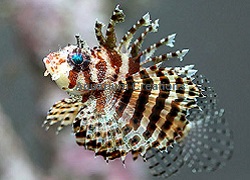
Click to view You Tube Video Fuzzy Dwarf Lionfish
Description:
The Dwarf Fuzzy Lionfish is also called the Shortfin Lionfish. It has vertical stripes along the body with large, fan-like pectoral fins and tall, quill-like dorsal fins. One of the best of the dwarf lions that an aquarist can keep in their aquarium. They are hardy, disease resistant, easily weaned onto prepared foods, and are an actively swimming lionfish. They have a unique fuzzy texture to their scales and possess semi-circular pectoral fins that are decorated with stripes and patterns. The fin rays are short and connected with solid webbing. During the day, D. brachypterus tend to hang upside down in caves or on soft corals. During the dawn/dusk periods, the dwarf fuzzy lionfish become very active and swim about in search of food.
Tank Recommendations:
A 30 gallon or larger aquarium is acceptable.In 30 gallon tanks only one specimen is recommended as Dwarf fuzzy lions will harass conspecifics within a size-limited tank habitat. In tanks over 100 gallons one may keep one male and two females together. Out of all the lionfish species, Dwarf fuzzy lionfish may be the best suited for a reef tank; they have small mouths, don't usually bother similarly-sized fish, and tend to stay to themselves.
Food and diet:
Though we do our best to have our Lionfish accepting a captive diet, many times lionfish revert back to live foods due to the stress of shipping and a new environment. If your Lionfish is not eating, we recommend feeding live Feeder Shrimp mixed with frozen mysis shrimp. Slowly increase the frozen mysis shrimp and decrease on the live Feeder Shrimp. Eventually cut out the live all together. This can take a few days or a few weeks depending on the stress level, health, age, and willingness on the individual fish.
The Lionfish diet consists of meaty foods such as live shrimp, live fish, and crustaceans. When first brought into your home aquarium use live saltwater feeder shrimp and feeder fish to entice your lionfish to eat. Once comfortably eating the above in the aquarium, start working with frozen mysis shrimp, pieces of uncooked table shrimp, pieces of thawed out silversides, and pieces of thawed out frozen squid.
Level of Care:
Moderate
Acclimaton Time:
3+ hours
Reef Compatibility
:with caution
Approximate Purchase Size:
Small: 1-1/2" to 2"; Medium: 2" to 3"; Large: 3" to 4"
Stung by a lionfish?
Lionfish spines on the dorsal, pelvic, and anal fins are all venomous. If accidentally stung, the affect is similar to a strong bee or wasp sting. The most important thing to remember is HEAT! Lionfish venom contains proteins that are broken down by heat, which takes the pain away and prevents the proteins from entering the bloodstream. After a sting, carefully remove any broken spines that may be in your wound and immediately place the wound in the hottest water you can stand (not scalding), keep heating more water with a microwave. Keep hot water on the wound for 30 minutes. The heat will clear the venom and remove the pain. Just remember, if the sting warrants, seek medical attention. Only you know how serious your condition is.
|
Small $39.99
Medium $49.99
Large $59.99
|
|
Aquarium Conditioned
Antennata Lionfish
Pterois antennata
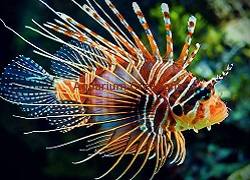
You Tube Video of the Antennata Lionfish
Description:
The Antennata Lionfish is easily recognized by the spots, which are often blue, on the inner surface of the large pectoral fins. It can be a durable aquarium fish that readily adapts to captive life if provided with adequate hiding places. If you keep more than one specimen, provide each individual with its own shelter site. This species is usually indifferent toward its tankmates, including members of its own kind and other lionfishes, unless they are small enough to swallow. Although it feeds on crustaceans in the wild, it will eat any fish that is small enough to fit in its mouth in the aquarium. Provide with plenty of open swimming space as well as caves and crevices for its to refuge in. It may spend more time in the open in a dimly-lit tank.
Tank Recommendations:
An adult dwarf lionfish will do well in an aquarium as small as 30-gallons with a number of hiding places and a large open area for swimming.
Food and diet:
Though we do our best to have our Lionfish accepting a captive diet, many times lionfish revert back to live foods due to the stress of shipping and a new environment. If your Lionfish is not eating, we recommend feeding live Feeder Shrimp mixed with frozen mysis shrimp. Slowly increase the frozen mysis shrimp and decrease on the live Feeder Shrimp. Eventually cut out the live all together. This can take a few days or a few weeks depending on the stress level, health, age, and willingness on the individual fish.
The Lionfish diet consists of meaty foods such as live shrimp, live fish, and crustaceans. When first brought into your home aquarium use live saltwater feeder shrimp and feeder fish to entice your lionfish to eat. Once comfortably eating the above in the aquarium, start working with frozen mysis shrimp, pieces of uncooked table shrimp, pieces of thawed out silversides, and pieces of thawed out frozen squid.
Level of Care:
Moderate
Acclimaton Time:
3+ hours
Reef Compatibility
:with caution
Approximate Purchase Size:
Small: 1" to 1-1/2"; Medium: 1-1/2" to 3-1/2"; Large: 3-1/2" to 5"
Stung by a lionfish?
Lionfish spines on the dorsal, pelvic, and anal fins are all venomous. If accidentally stung, the affect is similar to a strong bee or wasp sting. The most important thing to remember is HEAT! Lionfish venom contains proteins that are broken down by heat, which takes the pain away and prevents the proteins from entering the bloodstream. After a sting, carefully remove any broken spines that may be in your wound and immediately place the wound in the hottest water you can stand (not scalding), keep heating more water with a microwave. Keep hot water on the wound for 30 minutes. The heat will clear the venom and remove the pain. Just remember, if the sting warrants, seek medical attention. Only you know how serious your condition is.
|
Small $39.99
Medium $59.99
Large $89.99
|
|
Aquarium Conditioned
Fu ManChu Lionfish
Dendrochirus biocellatus
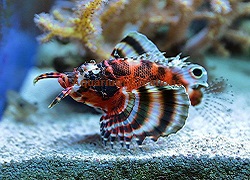
You Tube Video of the Fu Man Chu Lionfish
Description:
The Fu ManChu lionfish is a diminutive lionfish that can be readily identified by two large whiskers that protrude from either side of its mouth [Figure 4]. The fish is red-orange with blackish specks. The two solid pectoral fins resemble fans from a Spanish Dancer, and are circular with the lower fin rays forming angular points. This fish is a poor swimmer; instead, it tends to scurry across the substrate and will occasionally hop. What is remarkable with Fu ManChu lionfish is their prey stalking behavior. Once a prey item has been identified, the fish will approach and begin to shake its head and gill covers from side-to-side. When in capture range of the food item, the lionfish will begin to rhythmically twitch its dorsal spines back-and-forth, and as it readies to gulp the prey item, it vibrates the lower portions of its pectoral fins.
Tank Recommendations:
An adult Fu ManChu lionfish will do well in an aquarium as small as 30-gallons with a number of hiding places and a large open area for swimming.
Food and diet:
Though we do our best to have our Lionfish accepting a captive diet, many times lionfish revert back to live foods due to the stress of shipping and a new environment. If your Lionfish is not eating, we recommend feeding live Feeder Shrimp mixed with frozen mysis shrimp. Slowly increase the frozen mysis shrimp and decrease on the live Feeder Shrimp. Eventually cut out the live all together. This can take a few days or a few weeks depending on the stress level, health, age, and willingness on the individual fish.
The Lionfish diet consists of meaty foods such as live shrimp, live fish, and crustaceans. When first brought into your home aquarium use live saltwater feeder shrimp and feeder fish to entice your lionfish to eat. Once comfortably eating the above in the aquarium, start working with frozen mysis shrimp, pieces of uncooked table shrimp, pieces of thawed out silversides, and pieces of thawed out frozen squid.
Level of Care:
Moderate
Acclimaton Time:
3+ hours
Reef Compatibility
:with caution
Approximate Purchase Size:
Small: 1" to 1-1/2"; Medium: 1-1/2" to 2-1/2"; Large: 2-1/2" to 4"
Stung by a lionfish?
Lionfish spines on the dorsal, pelvic, and anal fins are all venomous. If accidentally stung, the affect is similar to a strong bee or wasp sting. The most important thing to remember is HEAT! Lionfish venom contains proteins that are broken down by heat, which takes the pain away and prevents the proteins from entering the bloodstream. After a sting, carefully remove any broken spines that may be in your wound and immediately place the wound in the hottest water you can stand (not scalding), keep heating more water with a microwave. Keep hot water on the wound for 30 minutes. The heat will clear the venom and remove the pain. Just remember, if the sting warrants, seek medical attention. Only you know how serious your condition is.
|
Small $59.99
Medium $79.99
Large $99.99
|
|
Aquarium Conditioned
Radiata Lionfish
Pterois radiata
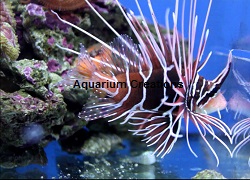
Click to view You Tube Video Radiata Lionfish
Description:
The Radiata Lionfish, Pterois radiata is also known as the Clearfin Lionfish, or Tailbar Lionfish. It is one of the most stunning of all the lionfish. Radiata Lionfish are mostly deep to bright red in color and have strong vertical white stripes. Radiata Lionfish also have amazingly elegant and long fins and quills. Radiata Lionfish reach a maximum adult size of around 10 inches in the wild. Radiata Lionfish are semi-aggressive fish and will try to eat just about anything that they can fit into their mouths. This makes them a gamble to add to reef tanks, since they might eat smaller tank mates. Known to spend time out in the open at dusk and dawn, in the ocean they hide in caves and under rock shelves during the daylight hours. Radiata Lionfish require hiding places such as crevices and caves. Keeping a lower light level will provide better viewing because they are active at night.
Tank Recommendations:
Requires a 75 gallon or larger aquarium with a number of hiding places and a large open area for swimming.
Food and diet:
Though we do our best to have our Lionfish accepting a captive diet, many times lionfish revert back to live foods due to the stress of shipping and a new environment. If your Lionfish is not eating, we recommend feeding live Feeder Shrimp mixed with frozen mysis shrimp. Slowly increase the frozen mysis shrimp and decrease on the live Feeder Shrimp. Eventually cut out the live all together. This can take a few days or a few weeks depending on the stress level, health, age, and willingness on the individual fish.
The Lionfish diet consists of meaty foods such as live shrimp, live fish, and crustaceans. When first brought into your home aquarium use live saltwater feeder shrimp and feeder fish to entice your lionfish to eat. Once comfortably eating the above in the aquarium, start working with frozen mysis shrimp, pieces of uncooked table shrimp, pieces of thawed out silversides, and pieces of thawed out frozen squid.
Level of Care:
Moderate
Acclimaton Time:
3+ hours
Reef Compatibility
:with caution
Approximate Purchase Size:
Small: 1-1/2" to 3"; Medium: 3" to 4-1/2"; Large: 4-1/2" to 6-1/2"
Stung by a lionfish?
Lionfish spines on the dorsal, pelvic, and anal fins are all venomous. If accidentally stung, the affect is similar to a strong bee or wasp sting. The most important thing to remember is HEAT! Lionfish venom contains proteins that are broken down by heat, which takes the pain away and prevents the proteins from entering the bloodstream. After a sting, carefully remove any broken spines that may be in your wound and immediately place the wound in the hottest water you can stand (not scalding), keep heating more water with a microwave. Keep hot water on the wound for 30 minutes. The heat will clear the venom and remove the pain. Just remember, if the sting warrants, seek medical attention. Only you know how serious your condition is.
|
Small $99.99
Medium $149.99
Large $169.99
|
|






